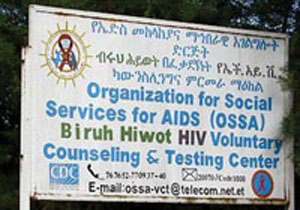20.1 The HIV epidemic in Ethiopia
We begin this study session by describing the current extent of the HIV epidemic in Ethiopia. In order to do this, we first need to remind you of several terms that you learnt in earlier study sessions, which you will need to know again here as we describe the epidemiology of HIV/AIDS. Epidemiology is the statistical study of the occurrence, distribution, potential causes and control of diseases, disabilities or other health problems in human populations.
In relation to disease epidemiology, can you recall the difference between prevalence and incidence?
Prevalence and incidence were described in Study Session 2 of this Module. Prevalence refers to the total number of cases of a particular disease or health condition existing in a population at a certain point in time, or during a given period (e.g. a particular month or year). Incidence refers only to the numbers of new cases of a disease or condition that are identified in a given period.
In the context of HIV/AIDS, you will also come across the term people living with HIV (abbreviated to PLHIV) when describing epidemic statistics, and indeed when we talk about other aspects of this disease. PLHIV refers to everyone who is infected with the virus, whether or not they remain in good health or have developed any HIV-associated diseases, including AIDS.
In Ethiopia, there were an estimated 1.2 million PLHIV in 2010. Thus, the prevalence of HIV infection in Ethiopia in 2010 was estimated to be 2.4% of the general population (2.9% of all females and 1.9% of all males). The HIV epidemic in Ethiopia is generally levelling off (stabilising), with signs of decline in major cities, but a rising epidemic in small towns and market centres. Women and children are particularly affected by HIV/AIDS; in 2010, close to 60% of the PLHIV in the country were females (totalling around 700,000 women) and about 80,000 were children.
Another important factor for you to consider in terms of the impact of HIV/AIDS in your community is geographical distribution. There is a marked variation in HIV infection between regions in Ethiopia (Figure 20.1).

Compare the prevalence of HIV infection in Addis Ababa to that of other regions in Figure 20.1. Would you expect HIV infection to be more prevalent in urban or rural areas in Ethiopia?
The prevalence of HIV in Addis Ababa, an entirely urban population, is much higher (9.2%) than in other regions with a mixed urban and rural population. Therefore, HIV infection appears to be more prevalent in urban than in rural areas.
Indeed, the average prevalence of HIV infection across all urban areas in Ethiopia is 7.7%, whereas in rural areas it is 0.9%. Another epidemiological factor that you should consider in order to help target prevention programmes is the fact that the highest HIV prevalence occurs in the 15–24 years age group. Note that reproductive health issues related to this risk group are covered in the Module on Adolescent and Youth Reproductive Health.

In response to the HIV/AIDS epidemic, the government of Ethiopia launched a free HIV/AIDS therapy programme in January 2005. Currently, about 550 health facilities, most of which are health centres, provide HIV/AIDS therapy services in Ethiopia, and you should become aware of the nearest one to your health post. Similarly, you should know the location of the nearest centres providing HIV counselling and testing services (see Figure 20.2; there are more than 2,184 sites providing counselling and testing in Ethiopia), and/or providing services for pregnant mothers (about 1,352 health facilities are mainly focused on prevention of mother-to-child transmission of HIV).
Learning Outcomes for Study Session 20
